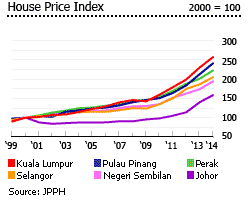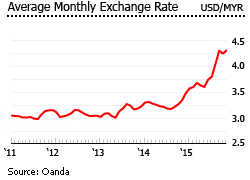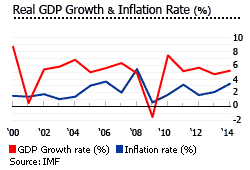Malaysia’s property market slowing sharply
 The economy is slowing, the ringgit is depreciating, and there's a political scandal affecting Prime Minister Najib Razak. House prices in Malaysia continue to rise, but at a slower pace, and transactions are slightly down and residential construction activity is slowing.
The economy is slowing, the ringgit is depreciating, and there's a political scandal affecting Prime Minister Najib Razak. House prices in Malaysia continue to rise, but at a slower pace, and transactions are slightly down and residential construction activity is slowing.
During the year to end-Q3 2015, the nationwide house price index rose by 5.43% (2.74% inflation-adjusted), down from an annual rise of 7.88% the previous year and the lowest increase since Q3 2009, according to the Valuation and Property Services Department (JPPH). On a quarterly basis, the index increased 0.8% (0.2% inflation-adjusted) in Q3 2015.
Malaysia’s average house price stood at MYR312,050 (US$72,519) in Q3 2015, up by 5.41% (2.72% inflation-adjusted) from a year earlier.
By property type:
- Terraced house average prices rose by 5.4% (2.7% inflation-adjusted) to MYR278,223 (US$64,658) during the year to Q3 2015
- High-rise residential properties' average price rose by 6% (3.3% inflation-adjusted) y-o-y to MYR296,826 (US$68,981)
- Detached house average prices rose by 4.1% (1.4% inflation-adjusted) y-o-y to MYR524,260 (US$121,835)
- Semi-detached house average prices increased 6% (3.3% inflation-adjusted) y-o-y to MYR469,823 (US$109,185)
Negeri Sembilan registered the highest y-o-y house price increase, at 7.3% (4.6% inflation-adjusted) during the year to end-Q3 2015, followed by Perlis (7.2%), Sarawak (6.7%), and Perak (6.6%).
Other areas with strong annual price rises included Selangor (6.2%), Kedah (6.1%), Kuala Lumpur (5.3%), Sabah (5.3%), and Terengganu (5.2%). Modest house price increases were seen in Pulau Pinang (3.5%), Melaka (3.3%), Pahang (3%), and Johor (3%). Only Kelantan saw a house price decline of 0.2% (-2.8% inflation-adjusted) during the year to end-Q3 2015.
Kuala Lumpur has the most expensive housing in Malaysia, with an average price of MYR718,755 (US$167,035) in Q3 2015. In contrast, Perlis had the cheapest, at an average house price of MYR156,324 (US$36,329).
Malaysia’s property market is expected to remain weak in the coming months, with house price rises slowing further next year.
Malaysia’s economic growth is expected to slow to 4.7% this year and to 4.5% in 2016, due to tighter fiscal conditions, according to the World Bank.
The ongoing political uncertainty is undermining confidence. PM Najib Razak has been engulfed by a scandal alleging that he had spent US$700 million from an Arab donor to ensure the victory of the United Malay National Organization (UMNO) in the 2013 elections. Worse, the government's seeming lack of interest in probing the matter has seriously eroded trust in government institutions.
House prices still below Asian crisis levels

Amazingly, house prices in Malaysia are still below pre-Asian Crisis 1997 levels, in inflation-adjusted terms. They rose rapidly in the early 1990s in two particularly dramatic surges – in 1991 house prices rose 25.5% (20.3% in real terms), and in 1995 they rose 18.4% (14.4% in real terms).
After the Asian Crisis, prices of luxury detached Kuala Lumpur houses then slumped 39% between 1997 and 1999. However since then Kuala Lumpur's house prices have significantly outperformed the rest of the country, especially after the economic downturn of 2008-2009, when the property market was revitalized with the help of the Greater Kuala Lumpur Plan, targeting developing key locations, including the latest “The MRT Project”. From 2005 to 2013, Kuala Lumpur house prices surged by more than 87% (53.2% inflation-adjusted).
In contrast national price rises have been more muted. From 2005 to 2013, Malaysia’s house prices rose by 40% (26.8% inflation-adjusted).
During 2014, Kuala Lumpur house prices rose by 11.72% (8.31% inflation-adjusted) while nationwide house prices rose by 9.38% (6.05% inflation-adjusted).
Residential property transactions falling
In Q3 2015, the total number of residential property transactions fell by 7.3% to 3,347 units from a year earlier, according to the Valuation and Property Services Department (JPPH). Condominiums and apartments accounted for more than 50% of total transactions.

The value of residential property transactions also dropped, but only slightly - by 0.93% to MYR2.53 billion (US$589.46 million).
Residential construction activity slowing

New residential launches fell by 12.8% to 27,231 units in H1 2015 from a year earlier, mainly due to mixed sentiment amongst the developers with regards to the GST implementation. There were about 68,351 newly launched residential units in 2014, according to JPPH. Selangor accounted for about 18% of the newly launched units, followed by Kuala Lumpur (17.4%), Johor (16.8%), and Perak (8.4%).
During the first half of 2015, new planned supply also plunged by 32.9% to 66,770 units from the same period last year.
However housing starts rose by 38% y-o-y to 100,712 units in H1 2015, though housing completions dropped 3% to 44,025 units over the same period, according to JPPH.
As of June 2015, Malaysia had a total residential stock of 4.89 million units, according to JPPH. About 29% of the total housing stock was in Selangor, 15% in Johor, 9% in Kuala Lumpur, and another 9% in Perak.
Mortgage market continues to expand

Malaysia’s mortgage market continues to expand, despite the Overnight Policy Rate (OPR) being raised to 3.25% in July 2014, where it remains. The size of the mortgage market grew to about 33.97% of GDP in 2014, up from 32.7% in 2013, 18.9% in 2004, and 13.1% in 1996.
In October 2015, total housing loans outstanding rose by 11.2% to MYR412.82 billion (US$95.94 billion) from the same period last year, according to Bank Negara Malaysia (BNM).
However despite the continued growth of the mortgage market, loan rejection rates in Malaysia were estimated to be as high as 70%, adversely impacting the residential property market, according to the country’s Real Estate and Housing Developers Association (REHDA). In fact during the first half of 2015, the amount of loan approvals for purchase of residential property dropped 25.8% from the same period last year.

To make home-buying possible for people on low and medium incomes and young people, in July 2011 the Malaysia People’s Housing (PR1MA) Bill 2011 was launched. Developers are as a result switching from high-end developments to mid-range to lure first time buyers with easier financing and reduced stamp duty for houses below MYR 400,000. Borrowers with a monthly income up to MYR 7,000 per month qualify for the scheme.
However homebuyers continue to find it difficult to finance their purchase of affordable homes.
Tighter lending and anti-speculation measures
Bank Negara Malaysia (BNM) has been tightening for several years.
BNM introduced stricter lending guidelines on January 1, 2012, requiring mortgage eligibility assessments to be based on net income, considering:
- Statutory deductions for tax;
- Employees Provident Fund (EPF) contributions, and;
- All other debt obligations.
In July 2013, BNM reinforced responsible lending practices:
- The new maximum home loan period was reduced to 35 years, from the previous period of 45 years.
- The maximum personal loan period was shortened to 10 years from 35 years.
- Pre-approved financing products are no longer possible.
Some other anti-speculation measures introduced by the government:
Fly-by-night developers targeted. Housing license project deposits of 3% of total estimated project cost were recently introduced. A MYR 500,000 fine, plus maximum of three-year jail term for developers who abandon projects, have been proposed by the Housing and Local Government Ministry.
Capital gains tax rises. On January 1, 2014, the Real Property Gains Tax (RPGT) rose from 15% to 30% on properties sold within three years from purchase.
Taxes on gains on properties sold after four to five years rose to 20% and 15%, respectively. No RPGT will be imposed on citizens for properties sold after six or more years, while companies will be taxed at 5%.
For non-citizens, RPGT on properties sold within a holding period of up to five years is 30%, while RPGT on properties sold within six years or more from purchase is 5%.
The end of the Developer’s Interest Bearing Scheme (DIBS). The government has forbidden banks from offering financing via the DIBS, introduced in 2009 to boost condominium sales, where the developer paid the interest on buyers’ loans during construction of a project.
Bulk sales. The Malaysian government also requires property developers to obtain permission before making bulk sales of more than four units.
Tougher restrictions on foreign buyers
The Malaysian government has partly retreated from its December 2006 liberalization of foreign property purchases. In January 2010, the price floor below which foreign buyers cannot buy was hiked to MYR 500,000, twice the previous level. From January 2014 it was hiked again to MYR 1 million (US$ 302,892). Foreign purchases above the threshold are placed under the “purview of the State Authorities” under the regulations, with approval expected to take one to two months.
Aside from this pricing threshold, there are no other restrictions that hinder non-resident foreign buyers in Malaysia. Malaysia along with Hong Kong and Singapore is one of the Asia-Pacific countries that imposes minimal restrictions on foreign property buyers (see Knight Frank’s July 2013 Asia-Pacific Residential Review).
There has been an upward trend in “Malaysia My Second Home” (MM2H) applications in recent years. The number of application approvals increased to 3,675 in 2013, from 3,227 in 2012, 2,387 in 2011, and 1,499 in 2010. From 2002 to 2012, the “Malaysia My Second Home” (MM2H) programme attracted 19,488 foreign buyers. However partly due to stricter regulations, the number of application approvals dropped to 3,074 in 2014.
During the first eight months of 2015, there were about 1,136 approved applications under the MM2H programme. Most foreign buyers (out of the 122 countries) came from China (23.3%), Japan (13.4%), Bangladesh (10.9%), United Kingdom (7.9%) and Iran (4.7%).
Moderately good yields, but the rental market is small
Condominium gross rental yields generally range from 5% to 7%, according to Global Property Guide research of April 2015. Bungalows have lower yields, typically just over 4%.
Gross rental yields in the capital city have fallen over the past year. Rents have not kept pace as nominal prices have risen. Yet the decline has been gentle, almost invisible. The 120 sq. m. condominium category remains the best-paying investment, with gross returns of 7%.
Malaysia has a small rental market. Only 6% of the housing stock is in the private rental sector. About 85% of total stock is owner-occupied, while government-provided housing accounts for 7% of the stock.
The government’s Economic Transformation Programme (ETP) has helped to increase the demand for luxury condominiums in Klang Valley, which caters mainly to foreigners, according to C.H. Williams Talhar & Wong.
Residential rents:
- In W.P. Kuala Lumpur, single storey terraced houses in Taman Tun Dr Ismail and Bangsar rent for MYR2,100 (US$488) to MYR2,300 (US$535) per month, while double storey terraced houses in Sri Hartamas and Bangsar ranged from MYR2,500 (US$581) to MYR2,800 (US$651).
- In Selangor, single storey terraced houses in the prime area of Petaling rent for an average of MYR2,000 (US$465) per month while double storey terraced houses in Bandar Utama were offered for as high as MYR3,500 (US$813) per month.
- In Johor Bahru, single storey terraced houses have an average monthly rent of more than MYR1,000 (US$232) while double storey terraced houses were rented for MYR3,000 (US$697) per month.
Economic slowdown

The Malaysian economy grew by a robust 6% in 2014, up from growth of 4.7% in 2013, 5.5% in 2012, and 5.3% in 2011, according to the International Monetary Fund (IMF). Economic growth is expected to slow to 4.7% this year and to 4.5% in 2016, due to tighter fiscal conditions, according to the World Bank.
From 2002 to 2008, economic growth averaged 5.7%, but growth fell sharply to 1.5% in 2009, during the global financial crisis. In 2010 GDP growth bounced back, surging by 7.5%.
In recent months, inflation has been rising after the government enforced the 6% goods and services tax (GST) in April 2015 and raised the excise tax on cigarettes in November 2015. The nationwide inflation rate stood at 2.6% in November 2015, according to the Department of Statistics Malaysia.
For 2016, the country’s inflation is expected to increase to 3.5%, driven mainly by a series of price hikes, the lagged effect of GST, and imported inflation.
BNM kept its Overnight Policy Rate (OPR) at 3.25% in September 2015, after raising it by 25 basis points in July 2014, despite recent higher inflation. The central bank is expected to keep the OPR unchanged next year, following the Fed’s move to increase the fed funds rate to 0.25%-0.5%.
The ringgit (MYR) remains weak. In 2015 the domestic currency shed almost 23% of its value to USD1 = MYR4.2925, its worst yearly decline since the Asian financial crisis year of 1997. The ringgit is expected to depreciate further in 2016 to reach between MYR4.49 and MYR5.00 to the US dollar.
“The weak global crude oil price and uncertainties domestically are ongoing challenges for the ringgit," said AmResearch.
Unemployment was 3.1% in October 2015, up from 2.7% in the same period last year, according to the Department of Statistics Malaysia.
There were about 2.1 million registered immigrants in the country, of which over one million are likely undocumented. To boost the economy, the World Bank has suggested that a 10% net increase in low-skilled foreign labour might boost the country’s real GDP growth by up to 1.1%.
Election spending scandal

In the May 5, 2013 elections in Malaysia, the ruling Barisan Nasional (BN) coalition, dominated by Prime Minister Najib Razak’s party, United Malays National Organisation (UMNO), took over 60% of parliamentary seats, despite getting only 47.38% of the popular vote. The opposition Pakatan Rakyat (PR) coalition led by Anwar Ibrahim failed to win majority even though it won 50.87% of the popular vote.
Anwar accused PM Razak and the Election Commission (EC) of electoral fraud. Recent investigations revealed that Razak spent US$700 million from an Arab donor to ensure that UMNO would remain in power during the 2013 elections.
Critics continue to be disappointed by the slow development of the investigations.